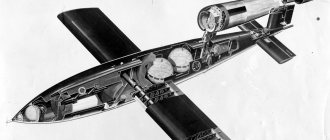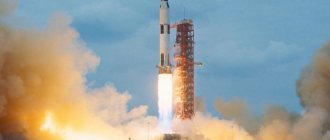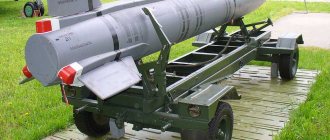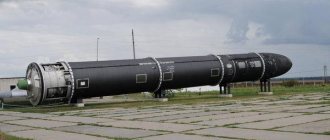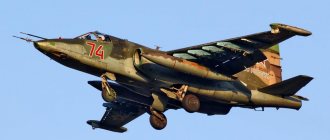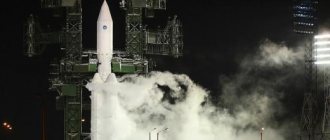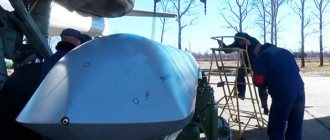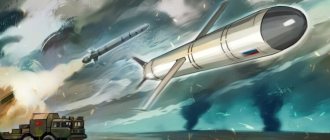In 1942, the tide of World War II began to change, and not in favor of Nazi Germany. Heavy defeats dispelled the impression created by the brilliant victories of the Reich in the initial campaigns. Naturally, German propaganda continued to assure ordinary people that victory would be achieved. But, which is significant, a special role in achieving a future victory was not assigned to the genius of the Fuhrer or the courage of the soldiers. The triumph was to be ensured by the “miracle weapon”.
The “wunderwaffe” also includes “weapons of retaliation” - cruise and ballistic missiles, which were supposed to strike Britain, replacing aviation.
V-1 cruise missile
The first “weapon of retaliation” was the Fi 103 projectile, developed since the summer of 1942. This unmanned, straight-wing monoplane was powered by a simple and inexpensive pulse jet engine mounted above the fuselage. The V-1 autopilot kept the rocket on a given course and altitude using gyroscopes and a magnetic compass.
The range of the V-1 was set by a mechanical counter, which was twisted to zero by an aerodynamic turntable on the nose of the projectile. When the counter reached zero, the “drone” went into a dive.
The V-1 warhead contained up to a ton of ammotol.
The rocket was launched from a steam catapult about 50 meters long. Such a launcher was not very mobile and was easily detected by aerial reconnaissance aircraft.
Characteristics of "Fieseler"-103 or V-1
A country:GermanyType:Projectile planeYear of issue:1942Crew:0-1 peopleEngine:1x As.014 with a power of 300 kgfMaximum speed:800 km/hPractical ceiling:1000 mRange of flight:280 kmEmpty weight:1500 kgMaximum take-off weight:2250 kg (normal takeoff)Wingspan:5.3 mLength:7.73 mHeight:1.7 mWing area:8 sq.m.Weapons:The mass of the warhead is 850 kg.
V-2 ballistic missile
The family of ballistic missiles, created since the late 30s under the leadership of Wernher von Braun, bore the index “A” - “Aggregat”. The most famous of them - A-4, despite the digital designation, was the fifth in a series of projects, and first took off in the spring of 1942.
The structure of the V-2 hull included four compartments. The warhead was equipped with ammotol, the mass of the charge reached 830 kg. The control compartment contained a gyroscopic guidance system. The central, and largest, compartment was occupied by tanks with fuel and oxidizer. The fuel was an aqueous solution of ethyl alcohol, and liquefied oxygen acted as the oxidizer. Finally, the tail of the rocket was occupied by a liquid-propellant rocket engine.
Initially, the V-2 missiles were supposed to be launched from protected bunkers, but the air superiority won by the Allied aircraft did not even allow the construction of fortified positions to be completed. As a result, the missilemen “worked” from mobile field positions.
To prepare such a launch site, it was enough to find a flat piece of terrain and install a launch pad on it.
Mother of all rockets
On October 3, 1942, at the Peenemünde (the missile center of the Third Reich near the town of Peenemünde on the island of Usedom in the Baltic Sea in northeastern Germany), the third (but first successful ) test launch of the V-2 (“ A-4 ”) rocket was carried out. This was the fourth A-4 rocket in the order of construction. She flew 192 km . and reached an altitude of 90 km . The rocket's engine and control system worked relatively normally for the first time, although the rocket was unable to hit targets due to problems with the guidance system .
" V-2 " (from German V-2 - Vergeltungswaffe-2, weapon of retaliation; another name - German A-4 - Aggregat-4) is the world's first long-range surface-to-surface ballistic missile , developed by the German designer Wernher von Braun and adopted by the Wehrmacht at the end of World War II.
Wernher von Braun
Externally, the V-2 rocket had a classic spindle-shaped shape , with four cross-shaped air stabilizers ( rudders ).
The rocket was single-stage , had a length of 14 m , and a body diameter of 1.65 m . (diameter according to stabilizers - 3.6 m ), launch mass 12.8 tons , which consisted of the mass of the structure together with the propulsion system ( 3060 kg ), mass of fuel ( 8760 kg - about 4 tons of 75% ethyl alcohol and about 5 tons of liquid oxygen ) and the mass of the warhead ( 980 kg ). The rocket used 175 kg . hydrogen peroxide, 14 kg . sodium permanganate, and 17 kg . compressed air.
The V-2 consisted of
more than 30,000 individual parts, and the length of its electrical equipment wires exceeded 35 km .
| 1. Head fuse 2. Explosive tube 3. Warhead (weight 975 kg) 4. Main electric fuse 5. Plywood compartment 6. Nitrogen cylinders Power set 8. Tank with ethyl alcohol and water. Maximum weight 4170 kg. 9. Alcohol valve 10. Liquid oxygen tank. Maximum weight 5530 kg. 11. Insulated pipeline for supplying ethyl alcohol 12. Power element 13. Turbo pump 14. Turbine exhaust 15. Fuel pipe for regenerative cooling of the combustion chamber 16. Main fuel valve 17. Combustion chamber. Thrust 25,000 kgf. 18. Main valve for liquid oxygen 19. Graphite gas steering wheel (4 pcs.) 20. Aerodynamic steering wheel (4 pcs.) 21. Antenna 22. Steam generator for driving pumps 23. Hydrogen peroxide tank. Maximum weight 170 kg. 24.Glass wool insulation. 25. Control and radio monitoring system equipment 26. Instrument compartment |
The rocket was powered by a liquid-propellant jet engine running on 75% ethyl alcohol and liquid oxygen . Both fuel components were supplied to the engine by two powerful Walther centrifugal turbopumps , which were driven by C- and T-rack turbines The main components of the liquid-propellant rocket engine were a combustion chamber (CC), a turbopump unit (TNA), a steam and gas generator , tanks with hydrogen peroxide , and a battery of seven cylinders with compressed air . Engine power was 730 hp. , the speed of gas flow from the nozzle reached 2050 m/s , the temperature in the combustion chamber was 2700°C , the pressure in the combustion chamber was 15.45 atm . Fuel consumption was 127 kg/sec . The engine could operate for 60-70 seconds , developing a thrust of 27,500 kgf . and giving the rocket a speed several times higher than the speed of sound - up to 1700 m/s ( 6120 km/h ). The acceleration of the rocket at launch was 0.9g , and before fuel cutoff it was 5g . The speed of sound increased in the first 25 seconds of flight. The flight range reached 320 km , the trajectory altitude was up to 100 km , and at the time the fuel supply was cut off, the horizontal range from the starting point was 20 km , and the altitude was 25 km . (then the rocket flew by inertia):
The accuracy of the missile hitting the target ( circular probable deviation ) was according to the project 0.5-1 km . ( 0.002 - 0.003 of the range), but in reality it was 10-20 km . ( 0.03 – 0.06 from range).
Ammotol (a mixture of ammonium nitrate and TNT was used as an explosive in the warhead due to its resistance to vibration and high temperatures - the head fairing heated up to 600 degrees during friction with the atmosphere. The warhead contained 730 - 830 kg . ammotol (the mass of the entire warhead was 1000 kg ). When falling, the speed of the rocket was 450 - 1100 m/s . The explosion did not occur immediately upon impact with the surface - the rocket had time to go a little deeper into the ground . The explosion left a crater with a diameter of 25-30 m . and a depth of 15 m .
The average cost of one rocket was 119,600 Reichsmarks .
Technologically, the rocket was divided into 4 compartments : combat , instrument , tank (fuel) and tail . This division was dictated by transportation conditions .
The combat compartment is conical in shape, made of mild steel thick . , with a total axial length (from the base of the fairing) of 2010 mm , equipped with ammotol. At the top of the fighting compartment was a highly sensitive impact pulse fuze . The use of mechanical fuses had to be abandoned due to the high speed of the rocket’s collision with the ground, as a result of which the mechanical fuses simply did not have time to operate and were destroyed. The charge was detonated by a squib according to an electrical signal received from the fuse. The signal cable from the head section was pulled through a channel located in the central part of the combat compartment.
The instrument compartment housed control system and radio equipment .
The fuel compartment occupied the central part of the rocket. Fuel (75% aqueous solution of ethyl alcohol) was placed in the upper ( front ) tank. The oxidizer —liquid oxygen—was filled into the lower ( rear ) tank. Both tanks were made of light alloy . In order to prevent changes in shape and damage, both tanks were pressurized with a pressure of approximately 1.4 atmospheres . The space between the tanks and the casing was tightly filled with a heat insulator ( fiberglass ).
In the tail compartment , on the power frame, the propulsion system . 4 stabilizers were attached to the tail section with flange joints . Inside each stabilizer there was an electric motor , a shaft , a chain drive of the aerodynamic rudder and a steering gear that deflected the gas rudder (located in the nozzle alignment, immediately behind its cut).
The rocket could be based either on a stationary ground launch pad or on a mobile installation . She started vertically . Before launch, the V-2 was strictly aligned in azimuth using a large guidance circle. an autonomous gyroscopic control system came into action , which had a stable platform, two gyroscopes and an integrated accelerometer . At the start, the direction was controlled by graphite blades , which flowed around the exhaust stream of the engine ( gas rudders ). During the flight, the direction of the rocket's movement was regulated by aerodynamic rudders of the blades , which had an electro-hydraulic drive .
swept wings and enlarged aerodynamic rudders on it . Theoretically, such a rocket in flight could glide to a distance of up to 600 km :
A-4b cruise missile on the launch pad in Peenemünde, 1944
Two experimental flights of such cruise missiles, called A-4b , were made at Peenemünde in 1944 . The first launch was a complete failure. The second rocket successfully gained altitude, but its wing came off as it entered the atmosphere.
The first test launch of the V-2 took place in March 1942 , and the first combat launch took place on September 8, 1944 . combat missile launches carried out 3225 . The rocket was used for the purpose of intimidation, hitting mainly civilians . The shelling was mainly carried out on the territory of Great Britain , in particular the city of London , which has a large area, as well as other European cities.
V-2 victims, Antwerp, 1944
However, the military significance of the V-2 was negligible . The effectiveness of the missile's combat use was extremely low: the missiles had low hit accuracy ( 50% hit 10 km ) and low reliability (about half of the launched missiles exploded on the ground or in the air during launch, or failed in flight ; this was largely due to the sabotage activities of the anti-fascist underground in the concentration camp, whose prisoners made missiles). According to various sources, the launch of 2,000 missiles sent over 7 months to destroy London led to the death of over 2,700 people (i.e., one or two people ). To drop the same amount of explosives as was dropped by the Americans using four-engine B-17 (" Flying Fortress 66,000 would have to be used , the production of which would have taken 6 years .
The V-2 rocket was the first object in history to make suborbital space flight . In the first half of 1944 , in order to debug the design, a number of vertical missile launches were carried out with a slightly increased time to 67 seconds . engine operating time. The lift height reached 188 kilometers , which, by modern standards, is considered a suborbital flight , since the rocket overcame the 100-kilometer Karman line , accepted as the “beginning of space.”
Moreover, the hypothesis about the first German cosmonauts . It is based on information that on the basis of the V-2, since 1941 - 1942, a project of a 100-ton guided two-stage first in the world intercontinental ballistic missile A-9/A-10 “ Amerika-Rakete ”, or “ Projekt Amerika ” , 25 m , 4.15 m , with a flight range of 5000 km . for the bombing of New York and other cities on the east coast of the United States:
Here are the estimated technical data of this missile:
Purely technically, however, this missile was, rather, a supersonic cruise missile , since its second stage was a cruise rocket plane , moving not along a ballistic but along a gliding trajectory. To aim the head of a missile with a warhead at the target, it was planned to use a signal from a radio beacon at the beginning and middle of the flight , and at the final part - a pilot , who, shortly before the target, had to leave the small cabin by parachute and splash down in the Atlantic Ocean in the hope of being picked up by a German submarine after he made a suborbital space flight .
Uncontrolled flight variant A-9/A-10 . After the separation of the first stage at an altitude of 60 km . A-9 unguided cruise missile reaches a speed at the end of the active phase of about 10,000 km/h . After passing the top of the trajectory and returning to the dense layers of the atmosphere with the help of aerodynamic rudders, the dive stopped, and the subsequent movement of the rocket occurred in the form of a series of successive dives into the atmosphere . This flight pattern made it possible to dissipate the heat generated due to the friction of the rocket with the air into the surrounding space, and increase the flight range to 5000 km , of course, at the cost of reducing the speed at the target .
According to some data found in the literature, the winged second stage of the A-9 was tested several times, starting on January 8, 1945 .
As for the first stage - A-10 , according to some data it was not completed, and according to others - back in mid-1944, was built at the Peenemünde rocket launch site , larger than for A-4 , which could be used for launches of A -10.
There is also information about Operation Elster (“ Magpie ”) being carried out in New York at the end of 1944 to neutralize infiltrated German agents , whose task was to install radio beacons on the city’s skyscrapers . If so, the America-Rakete project may have been close to entering combat use. The full deployment of the US missile bombing project was apparently no longer possible, since the German missile site was subjected to Allied air raids, and then was occupied by Soviet troops in the early spring of 1945 .
If the A-9/A-10 missiles were nevertheless tested and there were pilots on board, then if the altitude in these launches was exceeded 100 km . they could be considered the first astronauts .
However, the fact of any significant work on the A9/A10 program raises strong doubts, since there is no material evidence of any practical implementation of work on the project. According to an investigation conducted by the magazine “ Technology for Youth ”, the program did not progress beyond sketches and calculations .
After the end of World War 2, the V-2 became the prototype of the first intercontinental ballistic missiles in the USA and USSR and other countries. Some American and Soviet rocket and space programs began with the launch of captured and later modified V-2 rockets. The first Chinese ballistic missiles, Dongfeng-1, R-2 missiles , created on the basis of the V-2.
On April 11, 1945, American troops captured Thuringia , where they discovered 54 assembled missiles. In addition, 35 V-2s were in the assembly shops in varying degrees of readiness.
V-2 on the assembly line of the Mittelwerk plant in Mount Konstein, July 3, 1945
Near the rocket factory, on the southern slope of Mount Konstein , 5 km . from the city of Nordhausen there was a concentration camp Dora (Dora-Mittelbau, Nordhausen) - a subdivision of the Buchenwald . The main purpose of the camp was to organize the underground production of weapons at the Mittelwerk plant, including V-2 missiles. In the camp, prisoners worked in tunnels specially cut into the mountain. It was one of the most difficult camps in Germany . However, there was an anti-fascist underground , which organized secret sabotage during the production of rockets, due to which about half of all launched V-2s did not reach their target.
25,000 corpses of prisoners were found buried , and another 5,000 people were shot before the American army advanced. Thus, the production of missiles claimed 10 times more lives than the missile attacks themselves.
About 100 V-2 missiles captured by American troops on 16 transport ships were sent to America, where they became a real discovery for American engineers. In the first post-war years, with the help of Wernher von Braun, the first American ballistic missiles were created on their basis: Redstone, Mercury, Jupiter , which played a key role in the implementation of the first US space successes :
In the United States, research on captured missiles was carried out as part of the Hermes . In 1946-1952, the US Army carried out 63 missile launches for research purposes and one launch from the deck of a US Navy aircraft carrier. However, due to the US parallel program to develop the all-American WAC Corporal series of missiles, development of the V-2 line in the US was limited.
The acquaintance with German military equipment also made a strong impression Soviet engineers . B.E. Chertok wrote about it , along with other rocketry specialists, to get acquainted with the German captured V-2 rockets:
“AMIsaev, then I, N.A. Pilyugin, V.P. Mishin and several other specialists were allowed to examine secret German weapons.
Entering the hall, I immediately saw a dirty black bell from which the lower part of Isaev’s torso was sticking out. He climbed headlong through the nozzle into the combustion chamber and used a flashlight to examine the details. An upset Bolkhovitinov sat nearby.
I asked:
- What is this, Viktor Fedorovich?
- This is something that cannot happen! - came the answer.
At that time we simply could not imagine a rocket engine of this size».
However, our engineers managed to exactly replicate the German rocket and create its domestic analogue R-1 . In parallel with this analogue, S.P. Korolev developed the R-2 , which already flew over a 600-kilometer distance. The last direct descendant of the V-2 was our R-5 , which became the first domestic rocket with a nuclear warhead :
Direct descendants of V-2
So, the birth of the greatest rocket of the 20th century , which then became the basis of space rockets , was paid for by thousands of lives - residents of European cities that were hit by missile attacks, prisoners of concentration camps. And in subsequent years, missiles were considered by the superpowers as a means of military dominance . All talk about peaceful research space flights was considered not just as fantasy , but as a harmful diversion of resources from the main goal - the creation of means of destruction, destruction, murder . Only for these purposes did the “powers of this world” consider it worthy and necessary to allocate huge funds. And only those designers who were cosmic dreamers and strong personalities rolled into one , such as S.P. Korolev , Wernher von Braun , V.P. Glushko and others, managed to direct part of this militant energy into a peaceful, research direction. Probably, subsequent space research atoned for the sacrifices that were made at the first stage of the development of rocket science in the 20th century. Or weren't they redeemed?
Some of the V-2s exported to the USA were used for scientific research .
On October 24, 1946, an automatic 35 mm camera mounted on a captured V-2 rocket launched by American military engineers from the White Sands ( New Mexico ) photographed the Earth for the first time 65 miles ( 105 kilometers ). These are the photos:
On February 20, 1947, the first living creatures , fruit flies , were launched into space using a V-2 rocket in the United States along a suborbital trajectory . A study was made of the effects of radiation exposure at high altitudes.
In 1948, , rhesus monkeys , Albert and Albert 1, were launched into the nose cone of captured V-2 rockets . During preparation for the flight, the monkeys had difficulty getting used to the conditions of the cabin , did not respond well to training, sometimes they had nervous breakdowns, and then they showed aggressiveness, which they fought by plunging the animals into a state of narcotic intoxication . After the launch they died of asphyxiation . The height of the rocket reached 63 km .
On June 14, 1949, the monkey Albert II was launched into space in the same way. Unfortunately, Albert II also died due to his parachute failing to open . But nevertheless, Albert II became the first monkey in the world to go into space , as he took off 133 km.
On September 16, 1949, Albert III , a Javan macaque , died at an altitude of 10.7 kilometers in a rocket explosion.
On December 8, 1949, Albert IV died during a flight, reaching an altitude of 130.6 kilometers .
On August 31, 1950, Mickey, Mighty, Jerry or Danger mice were launched into space aboard a V2. It is not known how many of them survived.
On April 18, 1951, the monkey, nicknamed Albert V, died due to parachute failure.
On September 20, 1951, Yorick , also known as Albert VI flew with 11 mice . , became the first monkey to survive a rocket flight . However, he died 2 hours after landing . Two mice also died. Their deaths were caused by overheating in a sealed capsule in the sun before they were found.
On May 21, 1952, the monkeys Patricia and Mike , who flew and survived the flight, flew only 26 kilometers . Patricia and Mike have lived their entire lives at the National Zoological Park in Washington, DC USA.
In the USSR in 1949 - 1951, launches of the successors of the V-2 were carried out - geophysical rockets R-1A ( V-1A ), R-1B ( V-1B ), R-1V ( V-1V ) for scientific purposes , including , with dogs on board (see project VR-190 ):
Application
The first large formation of missile forces, the 65th Army Corps, was formed at the end of 1943. It included a regiment that was supposed to launch V-1s, but for the sake of conspiracy it was called “anti-aircraft artillery.” A week after the landing of troops in Normandy, “retaliation strikes” against Britain began.
As the Wehrmacht retreated from France, positions from which it was possible to strike at London were lost, and “drones” began to be used to fire at strategically important ports in Belgium. The shells turned out to be extremely unreliable - up to a quarter of the launched V-1s fell immediately after launch. Equally high was the percentage of rockets whose engines failed during flight.
The V-1s that reached Britain collided with balloons, were shot down by fighters, and were destroyed by anti-aircraft fire.
To continue the bombing of London and reduce the risk of meeting with V-1 interceptors, they tried to launch it from a He.111H-22 aircraft. Studies have shown that in such attacks up to 40% of V-1s were lost, and almost a third of the carrier aircraft were destroyed.
The V-2s entered service only in the fall of 1944. Although the warhead of the new weapon was no more powerful, and the accuracy of hits left much to be desired, the psychological impact of using the V-2 was incomparable. The ballistic missile was not detected by radar, and it was impossible to intercept it by fighters.
For some time it was believed that V-2s were guided by radar - this led to work on creating jammers.
They stopped in December 1944. It was supposed to create an artillery barrier on the intended flight path. But false reports sent by British intelligence turned out to be a good way to counter the V-2. They reported that German missiles were consistently missing London, going into flight.
The missilemen adjusted their targeting, and the V-2s began to hit sparsely populated suburbs. Intelligence, naturally, began to report accurate hits and great destruction. V-2 launches against London (designated as a priority target by Hitler personally) and Antwerp continued until the spring of 1945.
During the Battle of Remagen, there was an attempt to use the V-2 as a tactical weapon. The Fuhrer ordered with their help to destroy the railway bridge across the Rhine captured by the Americans. None of the fired missiles hit the bridge, and one deviated from the target by 60 kilometers.
Two unsuccessful launches of the new V-2
Five of these vehicles were built by October 24, 1944. The first flight of the new product took place on December 27, 1944. However, it ended in failure. The rocket crashed almost immediately after launch due to steering failure. The second rocket was launched into the sky on January 24, 1945. It reached an altitude of 80 km. After which it went into stable flight at a speed of 1200 m/s. However, one wing of the rocket could not withstand the load and broke off. The flight was interrupted. For technical reasons.
Rapidly advancing Allied armies and supply chaos brought the program to a complete halt.
In the 1990s, during the heyday of legends about Nazis on the Moon and all that nonsense, the last A4b test was considered by enthusiasts to be a manned flight. And this was, in their opinion, not an A4b flight at all! And the real A9/A10 intercontinental ballistic missile aimed at New York! Enthusiasts claimed that Luftwaffe pilot Rudolf Magnus Schröder was on board. And that when this idea failed, he committed suicide. Having bitten into a capsule with arsenic. The rocket debris allegedly sank somewhere in the North Atlantic. Of course, this is all nonsense. However, this legend placed Schroeder in the virtual pantheon of certain “Phantom Astronauts”.
Specifications
Let us present the basic data of both samples of the German “weapon of retaliation”.
| Fi 103 (V-1) | A-4 (V-2) | |
| Starting weight, kg | 2200 | 12500 |
| Fuel weight, kg | 540 | 9760 |
| Weight of warhead, kg | 700-1000 | 730-830 |
| Maximum speed, km/h | 656 | 522 |
| Maximum range, km | 286 | 320 |
| Deviation from target, km | 0.9 (design) | 5.0 (based on Soviet tests) |
It is easy to notice, without even going into detail, that the V-2, delivering even a smaller explosive charge, was much larger in total mass than a primitive projectile aircraft. We can say that while the Reich could still afford to produce large batches of the V-1, the assembly of the V-2 was not easy for the economy.
At the end of the war, the Americans copied the V-1 and adopted it under the name JB-2. The American rocket differed favorably from the V-1 in that it was guided by radio commands and launched using compact powder accelerators.
The use of V-missiles in itself can be considered successful. Even taking into account the number of V-1s that failed or were destroyed by air defense systems, they justified the costs of their production. But the V-2, although they seem to be a more effective weapon due to the impossibility of interception and a high percentage of successful launches, were much more expensive.
And the production of ballistic missiles also consumed valuable resources. For example, in order to provide fuel for one V-2, it was necessary to process about 30 tons of potatoes into alcohol. And this at a time when food shortages were becoming noticeable.
The low accuracy of the missiles made them suitable only for use as weapons of terror, for shelling large cities.
There was no need to even talk about any targeted strikes on strategically important objects. Massive bombings would have been more effective - but Germany had nothing to carry them out. And most importantly, the time when Britain could be forced to leave the war had passed irrevocably by 1944.
During the period when the Wehrmacht was expelled from France, attacks on residential areas were more likely to provoke a desire to quickly finish off the enemy. But after the war, the victorious countries took full advantage of German developments in the field of missile weapons.
Combat use of the Fi.103 (V-1) projectile aircraft
Unlike modern cruise missiles, the V-1 (Fi-103) was not a highly accurate weapon, but rather a "highly inaccurate" weapon. The missile impact location fit into a square of 4x4 kilometers, so relative success could only be achieved by launching missiles in “packs”, moreover, at large-sized targets. Shooting at cities (it is difficult to find a larger target) seemed to be the optimal way to use the V-1 in combat. The first target of Hitler's cruise missiles was supposed to be London. Remembering the terrible bombing of Hamburg by British bombers in the summer of 1943, the Germans introduced another designation for the V-1: V-1, that is, Vergeltung-1, “weapon of retribution.”
Hitler was waiting for a miracle, but the miracle did not happen. The British knew in advance about the “weapons of retaliation” and first of all bombed the launch sites and factories for the production of V-1. The fighters were also promptly warned about the new German weapon, and since the flight of the projectile aircraft was carried out strictly in a straight line, and at a relatively low speed, the pilots soon learned to shoot them down quite easily along the way. By the end of the war, no more than 10% of the V-1s released reached the target.
The first combat use of the V-1 (Fi-103) took place on the night of June 16, 1944. 244 missiles were fired at London - partly from He-111H-22 aircraft, partly from ground launchers in Normandy. Of course, this was only a test balloon - the Nazis managed to rivet no less than 25 thousand aircraft-shells. However, until the surrender, they were never able to shoot this impressive arsenal: a total of 10.5 thousand V-1s were produced, for the rest there was simply not enough fuel and launchers.
In total, according to English data, 6,364 people died from “weapons of retaliation” and about 18,000 were injured.
Fi.103 (V-1, V-1) transported on an Ar-234 aircraft. Just think - the world's first jet bomber with the first full-fledged cruise missile on board!
No. 3. Testimony from residents of the village of Niviska about the work of the Blizna landfill
1. Testimony of Ivan Lukich, a resident of the village of Niviska Gorchakovsky.
Me in the period 1943-44. worked on the Pustków-Kochanówka railway. I was in the month of September, 15 km from Niviska, when I saw the flight of an extraordinary body in the air - a rocket, with fire in flight and buzzing like thunder (similar in sound to a Katyusha).
Then I heard a loud sound - an explosion of a falling torpedo. At the same time, all the windows and tiles from the roof flew out. After the torpedo fell, a German plane appeared, inspected the crash site, and then at night all the remains were taken out.
The Germans did not allow access to the fence in the Blizna area for 3 km. Anyone who showed up was arrested.
2. Testimony of a resident of the village of Niviska, Kharat Franciszek.
In April (14th) I was in the village. I saw with my own eyes the flight of a projectile aircraft. He flew with a terrible noise, like continuous thunder. During the flight, a fire was visible behind the plane, and behind it there was smoke - a white cloud. When the projectile was flying, the sound of the flight made the windows in the houses shake. Then, not far from the village, the projectile swayed and fell sideways on the wing... As it fell, it lay on the ground for half an hour and burned, and then an explosion occurred. The Germans arrived at the crash site only after discovering the site with the help of an airplane that appeared from the Blizna area. During the explosion in the village of Niviska, windows, roofs of houses, attached staircases, etc. were destroyed. After the explosion, the Germans arrived and picked up all the fragments. The flight was at an altitude of approximately 200 meters.
In addition, I myself saw the flight of such aircraft-shells over the village in the direction of Cape Kolbuszova, Awergów. On the day of the explosion, 6-7 more such aircraft-shells passed overhead in the indicated direction. And in the following days, after the explosion, torpedoes flew over the village, but all without wings. Their flight was high.
Signature.
3. Indications gr. Dushen Yuzefa from the village of Niviska.
When the plane-shell fell near the village of Niviska, I stood at a distance - about 200 meters. I first saw the plane-shell hit the ground, then it rose, flew about 30 meters, swayed and fell again, continuing to burn on the ground, but without noise. After this, half an hour later, a great explosion occurred. At this moment the police had already arrived. I myself saw how one German, standing 100 meters away at the moment of the explosion, was knocked over (he was riding a bicycle).
At the site of the first fall there is a cigar-shaped funnel 7 meters long and with a diameter at its largest point of 2 meters, then at 27 m there is a funnel of the final fall and explosion.
Resident of the village of Niviska - signature.
Residents were surveyed
engineer major Sorkin.
RGASPI. F. 17. Op. 127. D. 545. L. 35-36.
Certified copy. Typewritten text.
First in space
In 1956, Sergei Pavlovich Korolev considered the possibility of launching manned capsules along a suborbital trajectory using the R-5 ballistic missile. However, in the end he decided to go for orbital flight. Which Soviet engineers accomplished on April 12, 1961 using the R-7 intercontinental ballistic missile.
The first person to make a suborbital flight into space aboard what was essentially an improved V-2 was American astronaut Alan Shepard.
This happened on May 5, 1961. But this happened three weeks after the Soviet pilot Yuri Gagarin made one revolution around the Earth... Express your opinion! It is very important for us! To do this, log into the site using:
